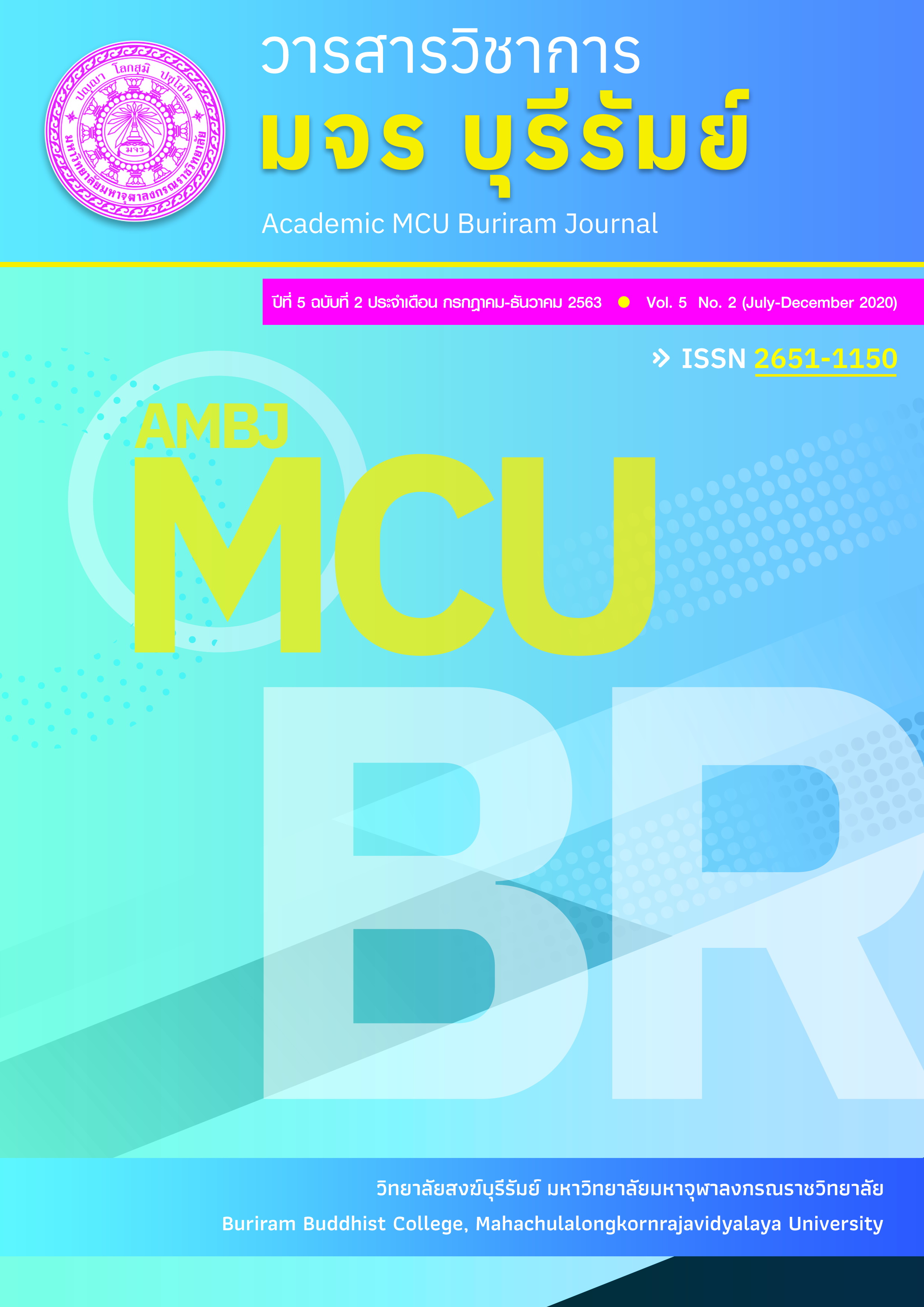ไส้เดือนตาบอดในเขาวงกต: การใช้โวหารภาษานำเสนอแนวคิดทางพระพุทธศาสนา
คำสำคัญ:
การใช้ภาษา, โวหารภาษา, แนวคิดในพระพุทธศาสนา, ไส้เดือนตาบอดในเขาวงกตบทคัดย่อ
บทความนี้มีวัตถุประสงค์เพื่อวิเคราะห์การใช้โวหารภาษานำเสนอแนวคิดทางพุทธศาสนาในนวนิยายเรื่อง ไส้เดือนตาบอดในเขาวงกตของวีรพร นิติประภา ในการศึกษาครั้งนี้เป็นการศึกษาเพื่อวิเคราะห์ข้อมูลโดยใช้วิธีศึกษาเอกสารตามขั้นตอนคือ 1) สำรวจและศึกษาเอกสารและงานวิจัยที่เกี่ยวข้องกับแนวคิดพุทธศาสนาและการใช้โวหารภาษาในวรรณกรรม 2) ศึกษานวนิยายเรื่องไส้เดือนตาบอดในเขาวงกตของวีรพร นิติประภา 3) วิเคราะห์การใช้โวหารภาษานำเสนอแนวคิดพุทธศาสนาในนวนิยายเรื่องไส้เดือนตาบอดในเขาวงกตของวีรพร นิติประภา ตามแนวคิดและทฤษฎีการใช้โวหารของปาริฉัตร พยุงศรี ตามประเด็นเกี่ยวกับบรรยายโวหาร พรรณนาโวหาร เทศนาโวหาร อุปมาโวหาร และสาธกโวหารและ 4) เสนอผลการศึกษาแบบพรรณนาวิเคราะห์
ผลการวิจัยพบว่า
วีรพร นิติประภานั้นได้ใช้อุปมาโวหารมากที่สุด รองลงมาได้แก่บรรยายโวหาร พรรณนาโวหาร และเทศนาโวหารตามลำดับ อย่างไรก็ตามไม่พบว่ามีลักษณะการใช้สาธกโวหารภาษา
เอกสารอ้างอิง
กมลทิพย์ กาลพันธ์. (2559). วรรณคดีร้อยแก้วสมัยรัตนโกสินทร์หลังได้รับอิทธิพลตะวันตก ประเภทบันเทิงคดี (นวนิยาย) ยุคแรก. (ออนไลน์). แหล่งที่มาhttp://lms.skru.ac.th/course/info.php?id=712.
จดหมายข่าวเทวาลัย สานสายใยชาวอักษรฯ. (2558). สรุปเนื้อหาการเสวนาไส้เดือนตาบอดในเทวาลัย. (ออนไลน์). แหล่งที่มา http://www.arts.chula.ac.th/dhevalai/ doc/ dhevalai_year7no30.pdf.
จิระนันท์ อนันต์ไทย. (2557). บทความรายการบ้านเมืองเรา: เรื่องสั้นและนวนิยายไทย.(ออนไลน์). แหล่งที่มาhttp://www.1374.org/5_radio/1_radio_isoc /1_banmuang/3_text/2557/7_57/10bm.pdf.
ไทยรัฐออนไลน์. (2559). ไส้เดือนตาบอดในเขาวงกต ผลงานวีรพร นิติประภา คว้าซีไรต์ปี 58. (ออนไลน์). แหล่งที่มา http://www.thairath.co.th/content/534156.
ธนกร ชูสุขเสริม. (2559). การวิเคราะห์เรื่องกายกับจิตในปรัชญาพุทธศาสนาเถรวาทและเดส์การ์ตส์. ออนไลน์) แหล่งที่มา file:///C:/Users/DR%20DAR0/Downloads /33300441.pdf.
บุญมี แท่นแก้ว. (2543). ญาณวิทยา (ทฤษฎีความรู้). กรุงเทพฯ: สำนักพิมพ์โอเดียนสโตร์.
ปาริฉัตร พยุงศรี. (2554). ภาษาที่นำเสนอแนวคิดพุทธศาสนาของสไบเมือง. วิทยานิพนธ์ ศศ.ม. (ภาษาไทย). กรุงเทพฯ: บัณฑิตวิทยาลัย มหาวิทยาลัยศรีนครินทรวิโรฒ.
พระธรรมปิฎก (ประยุทธ์ ปยุตโต). (2538). พจนานุกรมพุทธศาสน์ ฉบับประมวลธรรม, พิมพ์ครั้งที่ 9. กรุงเทพฯ: สหธรรมิก.
พระพรหมคุณาภรณ์ (ป.อ. ปยุตฺโต). (2545). พจนานุกรมพุทธศาสตร์ ฉบับประมวลธรรม.
กรุงเทพฯ: เอส. อาร์. พริ้นติ้ง แมส โปรดักส์ จำกัด.
โพสต์ทูเดย์-ข่าวบันเทิง. (2558). ไส้เดือนตาบอดในเขาวงกต คว้าซีไรต์ปี 58. (ออนไลน์).
แหล่งที่มา http://www.posttoday.com/ent/thai/395408.
ราชบัณฑิตยสถาน. (2542). พจนานุกรม ฉบับราชบัณฑิตยสถาน. กรุงเทพฯ: บริษัท สิริวัฒนาอินเตอร์ พริ้นท์.
วีรพร นิติประภา. (2558). ไส้เดือนตาบอดในเขาวงกต. กรุงเทพฯ: มติชน.
สถาบันการศึกษาเพื่อสร้างประชาธิปไตย. (2557). ความหมายของคำว่า ลัทธิอนาธิปไตย.
(ออนไลน์). แหล่งที่มา http://lovedemocracy01.blogspot.com/2014/03/ blog-post_1684.html.
สมเด็จพระญาณสังวร สมเด็จพระสังฆราช สกลมหาสังฆปริณายก. (2559). ความว่าง. (ออนไลน์). แหล่งที่มา http://www.dharma-gateway.com/monk/preach/ somdej/ sd-051.htm.
อรพรรณ จันทรวงศ์ไพศาล. (2557). ไส้เดือนตาบอดในเขาวงกต วีรพร นิติประภา นิยายรัก"น้ำเน่า"บนเงา"ความขัดเเย้ง. (ประชาชาติธุรกิจออนไลน์). แหล่งที่มา http://www.prachachat.net/news_detail.php?newsid=1396865505.
ASTV ผู้จัดการออนไลน์. (2558). ม้ามืด! นวนิยายไส้เดือนตาบอดในเขาวงกต โดยวีรพร นิติประภาคว้าซีไรต์ 58. (ออนไลน์). แหล่งที่มาhttp://www.manager.co.th/ CelebOnline/ViewNews.aspx?NewsID=9580000118302.
ดาวน์โหลด
เผยแพร่แล้ว
รูปแบบการอ้างอิง
ฉบับ
ประเภทบทความ
สัญญาอนุญาต
ทัศนะและความคิดเห็นที่ปรากฏในบทความวารสารฉบับนี้ถือเป็นความรับผิดชอบของผู้เขียนบทความนั้น ไม่ถือเป็นทัศนะและความรับผิดชอบของบรรณาธิการ





